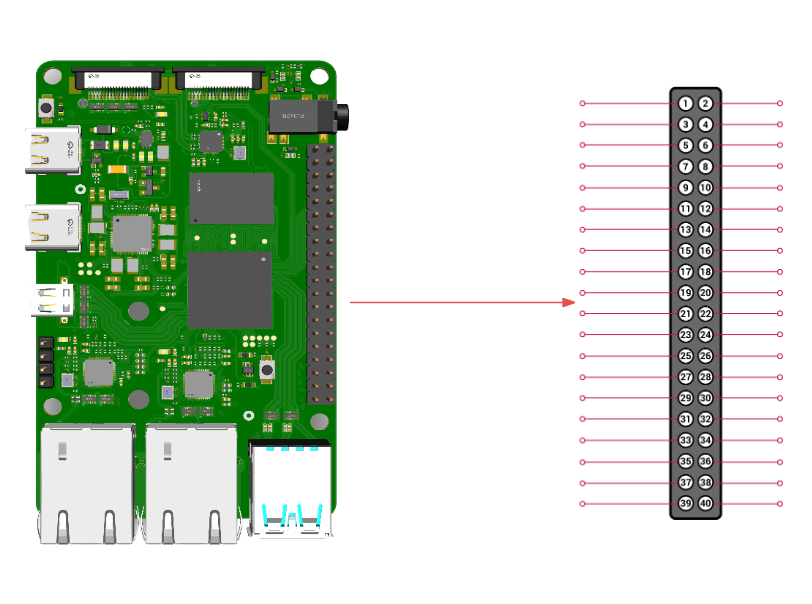GPIO and 40-pin header
A powerful feature of the PI ONE is the row of GPIO (general-purpose input/output) pins along the top edge of the board. A 40-pin GPIO header is found on all current Pi series boards. The GPIO headers on all boards have a 0.1in (2.54mm) pin pitch.

Pin Assignment
| Pin # | Function | Pin # | Function |
|---|---|---|---|
| 1 | CAN_TX | 2 | CAN_RX |
| 3 | ECSPI2_SS0 | 4 | ECSPI2_SCLK |
| 5 | ECSPI2_MOSI | 6 | ECSPI2_MISO |
| 7 | GPIO1_IO08 | 8 | GPIO1_IO14 |
| 9 | GPIO1_IO09 | 10 | GPIO1_IO10 |
| 11 | GPIO1_IO06 | 12 | GPIO1_IO07 |
| 13 | UART3_CTS_3V3 | 14 | UART3_RTS_3V3 |
| 15 | GND | 16 | GND |
| 17 | UART4_RXD_3V3 | 18 | UART4_TXD_3V3 |
| 19 | UART3_TXD_3V3 | 20 | UART3_RXD_3V3 |
| 21 | QSPIA_nSS0 | 22 | QSPIA_DATA0 |
| 23 | QSPIA_SCLK | 24 | QSPIA_DATA1 |
| 25 | SD3_DATA0 | 26 | QSPIA_DATA2 |
| 27 | SD3_DATA1 | 28 | QSPIA_DATA3 |
| 29 | SD3_DATA2 | 30 | SD3_DATA5 |
| 31 | GND | 32 | GND |
| 33 | SD3_DATA3 | 34 | SD3_DATA4 |
| 35 | I2C4_SCL_3V3 | 36 | I2C4_SDA_3V3 |
| 37 | I2C3_SCL_3V3 | 38 | I2C3_SDA_3V3 |
| 39 | 3.3V | 40 | 5V |
Voltages
5V pins and 3.3V pins are present on the board, as well as a number of ground pins (GND), which cannot be reconfigured. The remaining pins are all general-purpose 3.3V pins, meaning outputs are set to 3.3V and inputs are 3.3V-tolerant.
Outputs
A GPIO pin designated as an output pin can be set to high (3.3V) or low (0V).
Inputs
A GPIO pin designated as an input pin can be read as high (3.3V) or low (0V). This is made easier with the use of internal pull-up or pull-down resistors. Pins GPIO2 and GPIO3 have fixed pull-up resistors, but for other pins, this can be configured in software.
